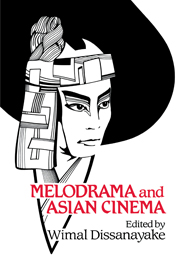Book contents
- Frontmatter
- Contents
- List of contributors
- Acknowledgments
- I Introduction
- II Melodrama / subjectivity / ideology: Western melodrama theories and their relevance to recent Chinese cinema
- III Symbolic representation and symbolic violence: Chinese family melodrama of the early 1980s
- IV The Goddess: Reflections on melodrama East and West
- V Melodrama as historical understanding: The making and unmaking of communist history
- VI Melodrama, postmodernism, and Japanese cinema
- VII Inscribing the subject: The melodramatization of gender in An Actor's Revenge
- VIII Insides and outsides: Cross-cultural criticism and Japanese film melodrama
- IX Psyches, ideologies, and melodrama: The United States and Japan
- X Negotiating the transition to capitalism: The case of Andaz
- XI The concepts of evil and social order in Indian melodrama: An evolving dialectic
- XII Politics of melodrama in Indonesian cinema
- XIII Power, pleasure, and desire: The female body in Filipino melodrama
- XIV The register of nightmare: Melodrama as it (dis)appears in Australian film
- XV Overview: What is American about film study in America?
- Index
VIII - Insides and outsides: Cross-cultural criticism and Japanese film melodrama
Published online by Cambridge University Press: 05 June 2012
- Frontmatter
- Contents
- List of contributors
- Acknowledgments
- I Introduction
- II Melodrama / subjectivity / ideology: Western melodrama theories and their relevance to recent Chinese cinema
- III Symbolic representation and symbolic violence: Chinese family melodrama of the early 1980s
- IV The Goddess: Reflections on melodrama East and West
- V Melodrama as historical understanding: The making and unmaking of communist history
- VI Melodrama, postmodernism, and Japanese cinema
- VII Inscribing the subject: The melodramatization of gender in An Actor's Revenge
- VIII Insides and outsides: Cross-cultural criticism and Japanese film melodrama
- IX Psyches, ideologies, and melodrama: The United States and Japan
- X Negotiating the transition to capitalism: The case of Andaz
- XI The concepts of evil and social order in Indian melodrama: An evolving dialectic
- XII Politics of melodrama in Indonesian cinema
- XIII Power, pleasure, and desire: The female body in Filipino melodrama
- XIV The register of nightmare: Melodrama as it (dis)appears in Australian film
- XV Overview: What is American about film study in America?
- Index
Summary
Japanese cinema presents a number of difficulties to a discipline of theory and criticism that has been developed in the West. While it is important not to apply inappropriate concepts to Japanese culture, it is equally dangerous to essentialize this national cinema as if it were immune to Western influence. Once we get beyond the exoticism of Orientalist critical discourse and anchor Japanese film in sociohistorical terms, we are in the domain of ethnography. What I would like to suggest here, by way of the melodramas of Ozu and Mizoguchi, is that Japanese ethnography has a specific ideological cast, and that national identity in Japan has a particularly melodramatic structure.
Much has been written about the mistakes made by a number of Western critics in construing Japanese formalism as radical modernism. Melodrama, unlike modernism, has deep roots in Japanese cultural history and might even be said to dominate Japanese cinema as a kind of metagenre to the same extent that it informs North American narrative film. In fact, emotional intensity is a key attribute of the socalled Japanese “character.” If a Western critic such as Ian Buruma can say that “every Japanese is equipped with a non-verbal emotional transmitter which functions only with other Japanese,” then an examination of the discourse of melodrama in Japan should shed some light on the representation of Japaneseness in the cinema.
Let me suggest, first of all, the degree to which theories of American melodrama “fit” the Japanese form, and the point at which they diverge.
- Type
- Chapter
- Information
- Melodrama and Asian Cinema , pp. 143 - 154Publisher: Cambridge University PressPrint publication year: 1993
- 13
- Cited by

